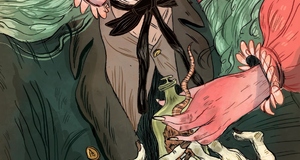Characterization in John Updike's "You'll Never Know, Dear, How Much I Love You"
By
2014, Vol. 6 No. 09 | pg. 2/2 | « Ben's innocence, as previously mentioned, is a major feature of “You'll Never Know, Dear.” The juxtaposition of enthusiasm and disappointment is expressed throughout the story. While no words are spoken when Ben finally enters the carnival, his actions alone are sufficient to provide readers with an avid comprehension of his character. The way in which he reacts to what he sees, in addition to the way he carries himself as he meanders through the fair, are precisely what Dowst describes as portraying actions. Updike's description of Ben's actions shows how this story is character driven: All the booth people, not really gypsies, stare at him, and beckon weakly. It hurts him to ignore the man with the three old softballs, and the old cripple at the merry-go-round, and the fat lady with her plaster Marys, and the skeleton suspended behind a fountain of popcorn. He feels his walking past them as pain. He wishes there were more people here; he feels a fool. (Updike, 1962, p. 173) The story progresses forward, showing how Ben's misdemeanor changes as he enters this sort of freak show, which is quite a shocking scene after the happy-go-lucky carnival he had envisioned. His decision to ignore them is painful but indicates his unworldliness, his fear as a child. Ben's fear is further demonstrated when he is near the girls who are singing. As their voices get louder, “the unbearable rising sugar of the chorus [makes] his scalp so tight he fears his head will burst from sweet fullness” (Updike, 1962, p. 175). The girls eventually move away from him, providing him with a temporary wave of relief until a man in suspenders begins telling horrible jokes to him and the fat ladies standing around him. Ben is initially filled with fear, but is thankful for the “nice fat factory and dustmop women that make him feel protected” in the midst of all the chaos (Updike, 1962, p. 175).Updike's descriptions of Ben's actions serve as great methods of characterization, and they also serve as a method to move the story along because they show Ben's growth as a character: from happiness, to fear, to mistrust. Readers are aware about a character's personality through his or her actions. According to Dowst (1921), “a reader of a story has a clue to the natures of its people in their actions, in their words, and what the writer has to say about them.” Dowst is a firm believer in the age-old saying, “Actions speak louder than words.” When creating a character, each character should have at least one trait that he embodies throughout the duration of the story. For instance, a character's main trait could be cruelty. Cruelty, then, in this case, would serve as the characterization, the driving point of the narrative. While cruelty is not necessarily a unique trait, it can bring a character to life if the “strict character trait, description or direct statement, dialogue, or action” is shown (Dowst, 1921, p. 137). However, simply stating that a character has a trait does not make him embody that trait. The only way in which a character can bring a trait to life and serve as a catalyst for the forward progression of a story is if the author shows the way in which the character exemplifies the trait. A final example of the way in which Updike's “You'll Never Know, Dear” is driven by the main character's description is in the first description of Ben's character, immediately after he receives the money from his parents: Over the roof of crazy Mrs. Moffert's house, the Ferris wheel tints the air with pink, and the rim of this pink mixes in excitement with the great notched rim of the coin sweating in his hand. This house, then this house, and past the ice plant, and he will be there. Already the rest of the world is there, he is the last, hurrying, hurrying, the balloon is about to take off, the Ferris wheel is lifting; only he will be left behind. (Updike, 1962, p. 173) Updike's description portrays Ben as a youthful character, full of wonder and exhilaration for what is in store for him. Furthermore, his physical descriptions are able to capture Ben as a typical child, an impatient young boy seeking instant gratification. Up until this point, the audience has no knowledge of who the protagonist is, whether it is a male or female, or the age. After this paragraph, however, the audience has a better grasp on who will be the main focus in the story. More physical descriptions of Ben come later in the story, as Ben walks past a man working at a game, yelling, “Hey, uh winneh. Hey, uh winneh, evvybody wins” (Updike, 1967, p. 174). Ben locks eyes with this man, engaging in “a stare of heartbreaking brown blankness” (Updike, 1967, p. 174). It is here the reader learns one of Ben's physical qualities: he has brown eyes. Updike provides a further depiction of Ben: [This]... blankness... seems to elucidate with paralyzing clarity Ben's state: his dungarees, his fifty cents, his ten years, his position in space, and above the particulars the immense tinted pity, the waste, of being at one little place instead of everywhere at any time. (Updike, 1967, p. 174) At this point, the audience receives a full-fledged character description. The protagonist of “You'll Never Know, Dear,” is a disheveled ten-year-old boy who wishes the world had more to offer him than this one specific place at this one specific moment in time has to offer him. The story arguably would not have the same effect if the character were older, worldlier, or maybe—if gender has the capability to change a situation—a female. Updike's description surely shows how characterization, in the physical sense, is adamant to the proper progression and overall success of a fictional work. Physical descriptions are essential to the portrayal of Updike's characters. In his article “John Updike: Style in Search of a Center,” Richard Rupp asserts that one reason for Updike's success “rests on his celebrated style, a restless, exhaustive exploration of minute physical detail” (Rupp, 1967, p. 693). Rupp discusses Updike's fixation on the physical presence of things. For example, “rhythmic phrasing, proper nouns, and brand names are all hallmarks of Updike's style” (Rupp, 1967, p. 693). Updike's narrative “You'll Never Know, Dear” is a prime example of a story that is driven and directed by its protagonist, as exemplified by the way Updike constructs Ben's thoughts, actions, and physical descriptions. While plot is undoubtedly an important part of a fictional work, in many cases, it is the characters who have the ability to steer the plot. Updike's character Ben expresses varying emotions of joy and shame that change the story from a carefree carnival to a commentary of the world as a “bitter coquette” (Updike, 1967, p. 178). His actions, from rushing to get into the carnival to hiding in the crowd once he is there, illustrate the effects he has on the story. Finally, his physical descriptions—tiny, ten-years-old, sweaty palms, wet knees jarring—all mesh to create a character who is able to take the narrative and turn it into an enrapturing journey. ReferencesBurns, R. (1998). Characterization. The Writer, 105(1), 11-14. De Bellis, J. (2000). The John Updike encyclopedia. Westport: Greenwood Press. Dowst, R.S. (1921). The technique of fiction writing. Franklin: University of California Press. Phillips, B. (2004). Character in contemporary fiction. The Hudson Review, 56(4), 629-642. Rupp, R. (1967). John Updike: style in search of a center. The Sewanee Review, 75(4), 693-709. Samuels, C.T. (1968). John Updike: the art of fiction. The Paris Review, 45. Samuels, C.T. (1969). John Updike. University of Minnesota Pamphlets on American Writers, 79. Minneapolis: University of Minnesota Press. Updike, J. (1962). You’ll never know, dear, how much I love you. In J. Updike (Eds.) Pigeon feathers and other stories (172-179). New York: Alfred A. Knopf. Suggested Reading from Inquiries Journal
Inquiries Journal provides undergraduate and graduate students around the world a platform for the wide dissemination of academic work over a range of core disciplines. Representing the work of students from hundreds of institutions around the globe, Inquiries Journal's large database of academic articles is completely free. Learn more | Blog | Submit Latest in Literature |
















